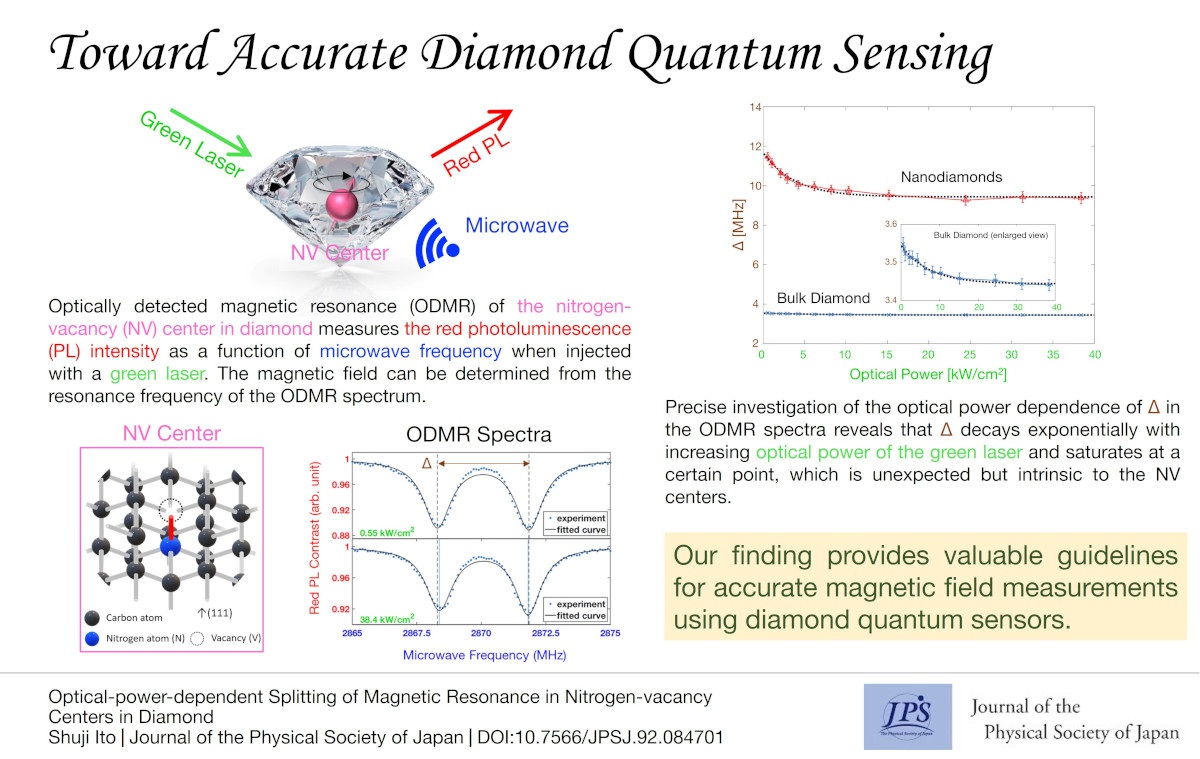Toward Accurate Diamond Quantum Sensing
© The Physical Society of Japan
This article is on
Optical-power-dependent Splitting of Magnetic Resonance in Nitrogen-vacancy Centers in Diamond
(JPSJ Editors' Choice)
J. Phys. Soc. Jpn.
92,
084701
(2023)
.
A systematic investigation of the optical power dependence of the response of diamond quantum sensors provides valuable guidelines for accurate magnetic field measurements.

The precise measurement of physical quantities based on the principles of quantum mechanics is called quantum sensing. A remarkable example is magnetic field measurements using nitrogen-vacancy (NV) centers in diamonds as quantum sensors. NV centers are a type of lattice defect in diamond crystals, in which a nitrogen atom and an atomic vacancy replace two adjacent carbon atoms. Among the many lattice defects, NV centers have unique properties that make them suitable for quantum sensing and have been applied to physical property measurements. NV centers are renowned for their high sensitivity. However, to take full advantage of their features, the accuracy (precision) and sensitivity of the measured physical quantities must be improved.
Optically detected magnetic resonance (ODMR) of NV centers measures the red photoluminescence (PL) intensity as a function of microwave frequency when green light is injected. The magnetic field can be determined from the magnetic resonance frequency of the ODMR spectrum. An unexpected phenomenon was recently reported: the ODMR spectra of NV centers in nanodiamonds (NDs) change with the optical power of the excitation light [M. Fujiwara et al., Phys. Rev. Res. 2, 043415 (2020)]. The spectral change is not drastic; hence, the phenomenon has been overlooked thus far. However, it can be problematic because it reduces the accuracy of low magnetic field measurements.
We systematically investigated the optical power dependence of ODMR spectra using NV ensembles in NDs and a bulk diamond single crystal. The experimental ODMR spectrum at zero magnetic field showed a slight splitting of the resonance frequency (Δ) owing to crystal distortion, nuclear spins near the NV centers, and so on. The Zeeman effect increased the frequency splitting in a finite magnetic field, making precise magnetic field measurements possible. We observed that Δ depended on the optical power in both NDs and bulk samples: it decayed exponentially with increasing optical power and saturated at a certain point. The decay amplitude depended on the samples, whereas the optical power at which the decay was saturated was almost independent of the samples.
The mechanism causing this unexpected phenomenon is most likely related to crystal distortion or a change in the charge state near the NV centers induced by photoexcitation. The present findings indicate that accuracy degradation can be suppressed by injecting an excitation light with an optical power above a certain value. Our achievement shows that there are unexplained phenomena even in the NV center, which has been studied for many years, and, at the same time, provides valuable guidelines for accurate magnetic field measurements using diamond quantum sensors.
(Written by Kensuke Kobayashi and Kento Sasaki on behalf of all the authors)
Optical-power-dependent Splitting of Magnetic Resonance in Nitrogen-vacancy Centers in Diamond
(JPSJ Editors' Choice)
J. Phys. Soc. Jpn.
92,
084701
(2023)
.
Share this topic
Fields
Related Articles
-
Shaping the Future of Materials Science with Tanabe–Sugano Diagrams
Dielectric, optical, and other properties in condensed matter
Electron states in condensed matter
Electronic structure and electrical properties of surfaces and nanostructures
Magnetic properties in condensed matter
2025-1-21
This special collection published in the Journal of the Physical Society of Japan celebrates 70 Years of Tanabe–Sugano Diagrams, highlighting their continued role in advancing materials with transition metals.
-
The Stiffness of Electronic Nematicity
Dielectric, optical, and other properties in condensed matter
Electronic structure and electrical properties of surfaces and nanostructures
Electronic transport in condensed matter
2024-11-21
Using laser-excited photoelectron emission microscope (laser-PEEM) we found that the nematic stiffness in iron-based superconductors significantly increases as the systems become strange metals, suggesting that spin–orbital fluctuations enhance the stiffness of electronic nematicity.
-
Discovery of Light-Induced Mirror Symmetry Breaking
Dielectric, optical, and other properties in condensed matter
Electronic transport in condensed matter
2024-9-2
The authors discovered the light-induced mirror symmetry breaking, paving the way for controlling mirror symmetries via light and for realizing various phenomena utilizing the mirror symmetry breaking.
-
d2 Trimer and d3 Tetramer in a Pyrochlore Lattice
Dielectric, optical, and other properties in condensed matter
Electron states in condensed matter
2024-7-11
Based on the charge disproportionation of V3+ and V2+, the V3+(d2) trimers and V2+(d3) tetramers in the vanadium pyrochlore lattice of AlV2O4 are described by the orbitally-induced Peierls mechanism.
-
Structural Rotation and Falsely Chiral Antiferromagnetism: A New Combination Generating Ferrotoroidic State
Dielectric, optical, and other properties in condensed matter
Magnetic properties in condensed matter
2024-7-4
The ferrotoroidic state, an exotic state of matter with broken space inversion and time-reversal symmetries, was achieved by combining structural rotation and falsely chiral antiferromagnetism in PbMn2Ni6Te3O18.




